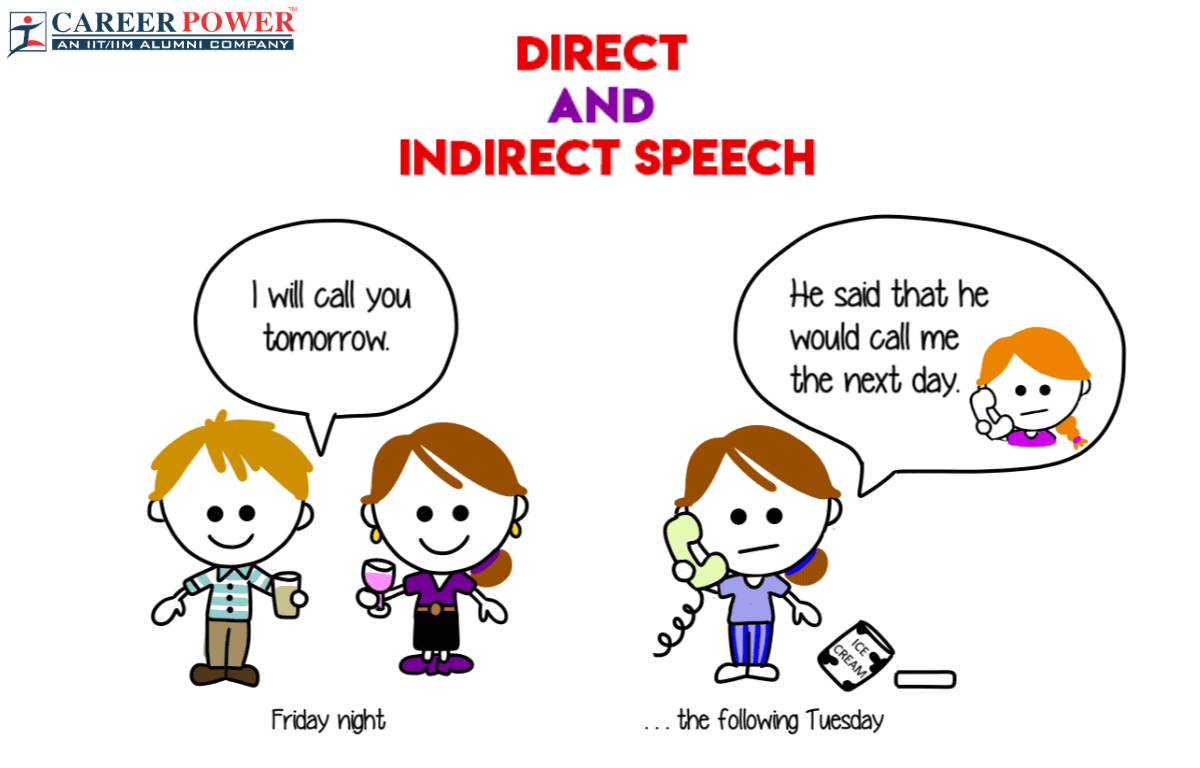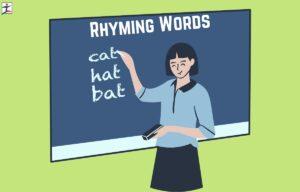Table of Contents
Direct and Indirect Speech: In English Grammar, direct and Indirect speech are used in instances when we wish to repeat or convey a speech or statement of some other person. Both direct and indirect speech describes what a third person said or conveyed in the past. Indirect speech is more commonly employed unless it’s a direct quotation, which is consistently enclosed in double quotation marks. Whereas indirect speech is used when you want to convey someone’s statement using your own precise words. It’s worth highlighting that indirect speech is consistently expressed using verbs like “said,” “told,” or “asked.”
Direct and Indirect Speech
There are two types of reported speech in English grammar, they are Direct and Indirect speech. Both speech conveys the speech or statement which was told by some other person. To explain any event, action or scenario we generally convey the sentences quoted by someone in the form of direct and indirect speech. In order to clearly differentiate and make people understand easily, we have detailed the two types of reported speech with examples and exercises below.
Direct Speech
Direct speech is the mode of expression that directly presents the words spoken or quoted by a third person. Generally, direct speech is written inside quotation marks (“”). The quotation is used to differentiate the speech of the third person that has happened in the past. Thus direct speech conveys statements or conversations of someone in the past tense but quoted inside the quotation marks in the present or future tense.
Examples:
- Kiran said, “I am doing my work.”
- They said, ” We will go for the function.”
- He asked,”Can I make this?”
Indirect Speech
Indirect Speech is used when we convey what someone said in our own words without repeating the actual text of that person. Instead of using quotation marks, the conjunction word, ‘that’ is used. Thus speaker’s words and sentences are reframed into our own words in Indirect speech. Some examples of indirect speech are:
- Direct speech: Kiran said, “I am doing my work.”
- Indirect speech: Kiran said that she is doing her work.
- Direct speech: They said, ” We will go for the function.”
- Indirect speech: They said that they would go to the function.
- Direct speech: He asked, “Can I make this?”
- Indirect speech: He asked whether he can make that.
Rules for Direct and Indirect Speech
There are certain rules and regulations followed while converting a simple direct speech into indirect speech. Certain factors such as Verbs, Tenses, Modals, time, place, and pronouns are also considered while changing. The following are the rules applied when you convert direct speech to indirect speech in English grammar.
Rule-1: Direct To Indirect Speech Conversion – Reporting Verb
The reporting verb is an important factor to note when changing a direct to an indirect sentence. When the reporting verb is past tense, then the verb inside the quotation is also changed to past when changing a sentence from direct to indirect speech.
Examples:
- Direct: He said,’ I am sad.’
- Indirect: He said that he was sad.
An exception is for cases like a universal truth, the tenses remain the same.
- Teena said” The sun rises in the east”.
- Teena said that the sun rises in the east.
If the reporting verb is in present/future tense, then the tense remains the same as in direct speech.
- Direct: She says/will say, ‘I am coming.’
- Indirect: She says/will say she is coming.
Rule 2: Direct Speech to Indirect Speech Conversion – Tenses
If the sentences inside quotes in direct speech are present tense, it is changed to past tense when changed to indirect speech. The rule in the following table is applied while changing tenses from direct speech to reported speech.
| Direct Speech | Indirect Speech |
| Present Simple Tense do /does V1 | Past Simple Tense did + V1 V2 |
| Present Progressive Tense is/am/are + V4 | Past Progressive Tense was /were + V4 |
| Present Perfect Tense has /have + V3 | Past Perfect Tense had + V3 |
| Present Perfect Progressive has been /have been + V4 | Past Perfect Progressive had been + V4 |
| Past Simple Tense did + V1 V2 | Past Perfect Tense had + V3 |
| Past Perfect Tense had/have + V3 | Past Perfect Tense had + V3 |
| Past Perfect Progressive had been/have been + V4 | Past Perfect Progressive had been + V4 |
| Future Simple Tense will + V1 | would + V1 |
| Future Progressive Tense will be + V4 | would be + V4 |
| Future Perfect Tense will have + V3 | would have + V3 |
| Future Perfect Progressive will have been + V4 | would have been + V4 |
Where V1- Base verb, V2- Simple past V3- Past participle V4- Progressive verb (verbs ending with ‘ing’).
Examples of change in Tenses
| Direct Speech | Indirect Speech |
| Ram said, “I do my work.” | Ram said that he did his work. |
| They said, “We are going now.” | They said that they were going then. |
| Sara said, ” I have done my work.” | Sara said that she had done her work. |
| Rohit said, “I have been doing my work.” | Rohit said that he had been doing his work. |
| Ram said, “I did my work” | Ram said that he had done his work. |
| They said,”We have done our work” | They said that they had done their work. |
| They said, “We have been doing our work.” | They said that they had been doing their work. |
| Ram Said, ” I had been doing my work.” | Ram said that he had been doing his work. |
| Sara said, “I will do my work.” | Sara said that she would do her work. |
| They said, “We will be going out.” | They said that they would be going out. |
| They said, “We will have done this work.” | They said that they would have done that work. |
| Ram said, “I will have been doing this work” | Ram said that he would have been doing that work. |
Rule 4: Direct to Indirect speech Conversion Interrogative sentences
If a sentence starts with a question word like what, when, and why in direct speech, the question word itself acts as the joining class.
Example:
- Direct speech: “Where do you live ?” Asked the boy.
- Indirect Speech: The boy enquired where I lived.
Rule 5: Direct to Indirect Speech Conversion Change in Modals
Modal verbs are those verbs that are preceded by another verb, which is the main verb. Can, May, and Must are some examples of Modals. Modals that won’t change are Could, would, should, ought to, might. While changing direct to indirect speech, the Modals change as below:
- Can become could
- May becomes Might
- Must becomes had to (or) would have to
Examples:
- Direct: She said,” She can sing.”
- Indirect: She said that she could sing.
- Direct: She said,” I should cook the lunch”
- Indirect: She said that she should cook the lunch.
Rule 6: Direct to Indirect speech conversion – pronoun
The first person in Direct speech changes as per the subject of the speech
Example:
- Direct: He said, “I am in grade sixth.”
- Indirect: He said that he was in grade sixth.
The second person of Direct speech changes as per the object of the indirect speech.
Example:
- Direct: She says to them, “You have achieved your goal.”
- Indirect: She tells them that they have achieved their goal.
If the third person is mentioned in the Direct speech, it does not change in reported speech.
Example:
- Direct: He says, “She sings well.”
- Indirect: He says that she sings well.
Rule 7: Direct to indirect speech conversion – Request, Command, Wish and Exclamation.
The imperative words in direct speech change into Infinitives in indirect speech.
Examples:
Request
- Direct: She said to her ‘Please remove it’.
- Indirect: She requested her to remove that.
Exclamation
- Direct: She said, ‘Alas! I am undone.
- Indirect: She exclaimed sadly that she was broke.
Rule 8: Direct to indirect speech conversion – punctuations
In Direct speech, the words spoken must start with(“) and ends with(.) inside the double inverted commas. All symbols such as question marks, full stops or exclamatory marks should be placed inside the quotes.
Examples:
- They said. “We are the best”
- She asked, “Can I come with You?”
- He uttered, “Keep Quiet!”
Rule 9: Direct to indirect speech conversion – Change of time
While converting direct speech to Indirect speech, there are certain words to be noted that cannot be used as such in indirect speech. These words get modified into new words which are enlisted below:
- Now becomes Then
- Ago becomes before
- Thus becomes So
- Today becomes That day
- Tomorrow becomes the next day
- Yesterday becomes the day before
- This becomes that
- These become those
- Come becomes go
- Hence becomes thence
- Next week or next month becomes the following week or month
Examples:
- Direct: He says/will say, ‘My girlfriend came yesterday.’
- Indirect: He says/will say that his girlfriend had come the day before.
Rules for Converting Indirect Speech into Direct Speech:
The following rules should be followed while converting an indirect speech to direct speech:
- Use the reporting verb such as (say, said to) in its correct
- Put a comma before the statement and the first letter of the statement should be in capital
- Insert question marks, quotation marks, exclamation marks and full stops, based on the mood of the
- Remove the conjunctions like (that, too, if or whether) wherever necessary.
- Where the reporting verb is in the past tense in indirect, change it to present tense in the direct
- Change the past perfect tense either into the present perfect tense or past tense, as necessary.
Direct and Indirect Speech – Some Exercises
The following are some exercises that students can practice while preparing for their revision tests or board exams.
Q.1. Find out the correct indirect speech for the given sentence.
She said,’ I have cooked this meal.’
- She said that she cooked this meal
- She said that she had cooked that meal.
- She said that I cooked that meal.
- She said that she had cooked this meal.
Answer (2) She said that she had cooked that meal.
Q.2. Choose the correct sentence.
Sanjay said, ‘What a beautiful painting it is’.
- Sanjay exclaimed wonderfully that the painting was very beautiful.
- Sanjay exclaimed with wonder that the painting was very beautiful.
- Sanjay exclaimed with wonder that the painting was very beautiful.
- Sanjay exclaimed with wonder that the painting was very beautiful.
Answer (4) Sanjay exclaimed with wonder that the painting was very beautiful.
Q.3. The correct indirect speech for She asked, “What is the cost of these books?”
- She enquired what was the cost of those books.
- She inquired what was the cost of these books.
- She enquired what is the cost of those books.
- She questioned what was the cost of those books.
Answer (1) She enquired what was the cost of those books.
Q.4. The man said, ‘Oh God! I missed the train today.’
- The man cried that he missed the train that day.
- The man exclaimed in grief that he missed the train today.
- The man said that oh God! he missed that day.
- The man exclaimed with sorrow that he missed the train that day.
Answer (4)The man exclaimed with sorrow that he missed the train that day.

 Learn 50+ Rhyming Words with Examples in...
Learn 50+ Rhyming Words with Examples in...
 Demonstrative Pronouns: Meaning, Definit...
Demonstrative Pronouns: Meaning, Definit...
 Report Writing Format, Examples for Clas...
Report Writing Format, Examples for Clas...
